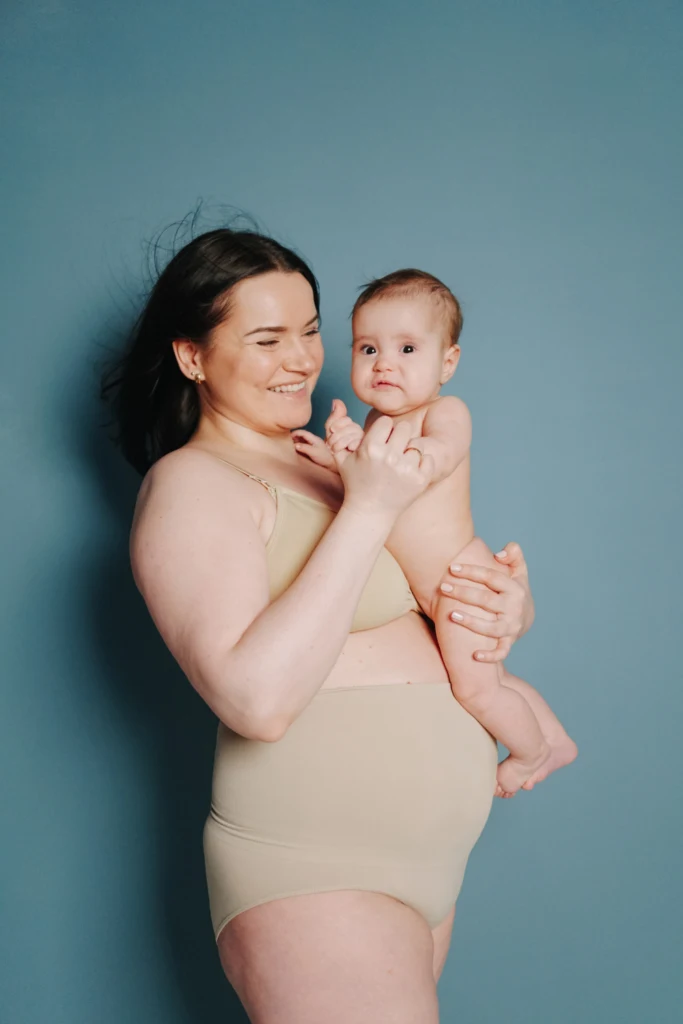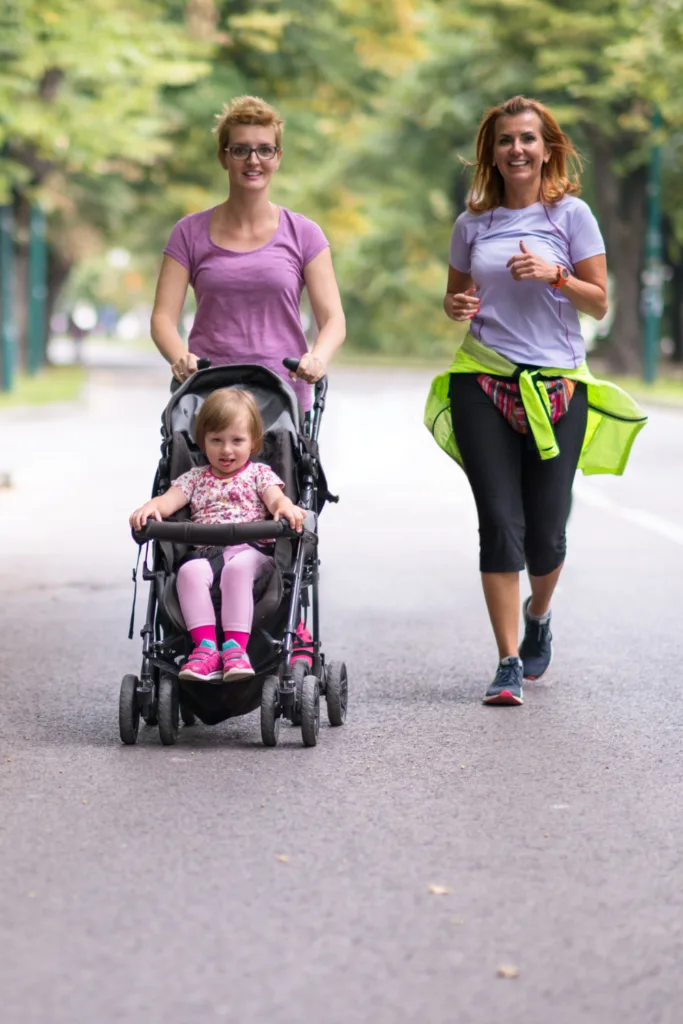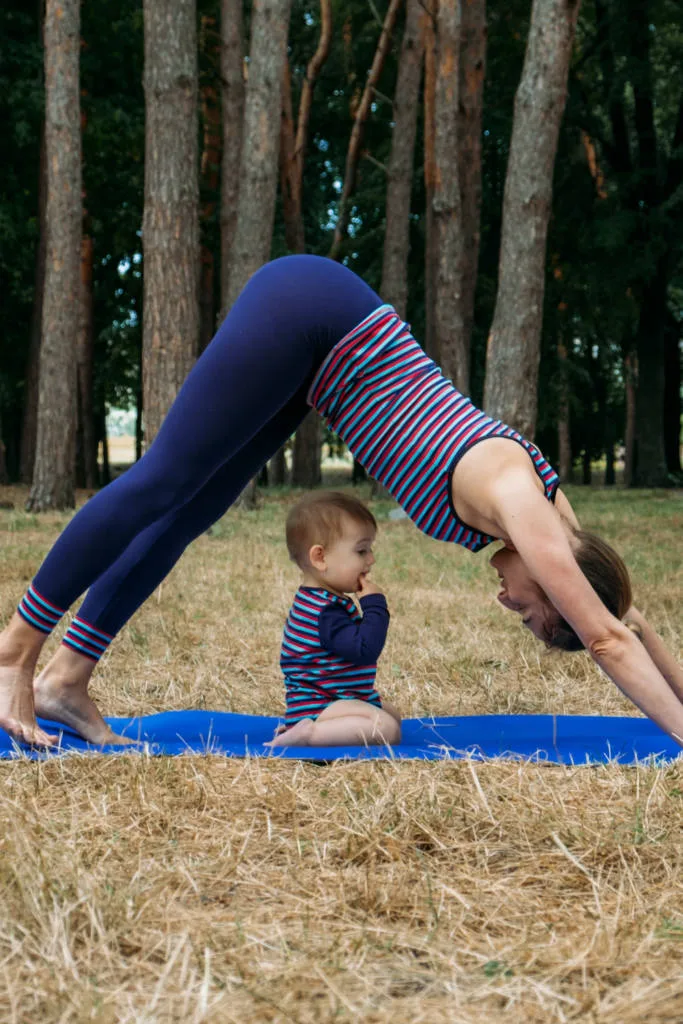Returning to exercise after pregnancy can be daunting and challenging.
Your body goes through A LOT during pregnancy and childbirth.
Many of the physiological changes of pregnancy persist for another 4 to 6 weeks, so it’s important you look after yourself during this crucial time.
You may be wondering if you’ll ever be able to return to exercise.
Undoubtedly, there will be challenges that you might face, but return to exercise after pregnancy is possible with the right guidance, support, motivation and mindset.
Patience and gradual progress are key so you don’t become overwhelmed too soon.
So take a deep breath and let’s dive in!
In this guide we’ll explore:
- What happens to your body after pregnancy?
- What are the benefits of exercise after pregnancy?
- When to start exercising after pregnancy?
- What are the recommended physical activities after pregnancy?
- How much exercise is appropriate after pregnancy?
- What are the barriers to exercise after pregnancy?
- How to stay motivated
- Exercise after pregnancy Q&A
- Tips for exercising after pregnancy
Ready?
Let’s get going!

What happens to your body after pregnancy?
Pregnancy and childbirth take a toll on your body.
There are a lot of physical changes that you have to contend with during this time.
Your lower back and abdominal muscles may be weaker than they used to be.
Your ligaments and joints may also be supple and flexible for a few months after childbirth, so there’s an increased risk of injury if you stretch or twist too much.
You may also experience one or more of the following conditions after pregnancy.
It’s important you understand these conditions and the risks associated with them before returning to any form of exercise routine.
If in doubt, speak to your doctor or midwife.
- Abdominal separation
- Pelvic floor weakness
- Postpartum bleeding
- Postpartum fatigue
Abdominal separation
Also known as diastasis recti, abdominal separation is when the two muscles that run down the middle of your abdomen separate during pregnancy.
This happens when your growing womb pushes the muscles apart to make way for your baby, making them longer and weaker.
The amount of separation can vary from woman to woman.
According to the NHS, your muscles will normally go back to normal by the time your baby is 8 weeks old.
If the separation is still obvious after 8 weeks, get in touch with your doctor and they may refer you to a physical therapist.
Pelvic floor weakness
Your pelvic floor muscles are the muscles that support your bladder, bowel and uterus.
These muscles become weakened during pregnancy and childbirth.
Pelvic floor dysfunction can cause incontinence and prolapse, so it’s important you strengthen them by doing pelvic floor exercises.
Other problems associated with pelvic floor weakness include pain with sex, pain with urination and bowel pain.
You may also experience pelvic floor dysfunction if you have painful periods or endometriosis.
Postpartum bleeding
You’ll bleed from the vagina after childbirth. This normally lasts for a few weeks.
It is recommended you use super-absorbent sanitary pads, and not tampons, for the first 6 weeks to prevent infection.
Make sure you change them regularly and wash your hands before and after changing your pad.
If you pass any large clots during this time, tell your midwife and they’ll be able to advise on the best treatment.
Postpartum fatigue
During the postpartum phase you may experience a persistent lack of energy which may affect your concentration and attention.
According to research, postpartum fatigue affects 42% of women in the first few days after childbirth.
This figure rises to up to 64% at 5 to 6 weeks after childbirth, and up to 67% at 12 to 14 weeks.
Research tells us that you are more at risk of postpartum fatigue if you had a longer labour and instrumental or operative delivery.
Other risk factors include anaemia, infection and haemorrhage during the postpartum period.
Related: Running while pregnant: Is it safe? 7 exercise tips during pregnancy

Related: Exercise after hernia surgery: The complete guide for women
What are the benefits of exercise after pregnancy?
The benefits of exercise are well documented.
Exercising outdoors each week has lots of benefits for your physical and mental health.
The same goes for exercise during the postpartum period.
Postpartum physical activity helps to:
- Improve your mood
- Improve cardiorespiratory fitness
- Improve weight control
- Promote weight loss
- Promote better sleep
- Reduce symptoms of anxiety and postpartum depression
Related: Can you exercise during IVF? Tips + exercises to avoid
When to start exercising after pregnancy?
There is no one size fits all approach when it comes to exercise after pregnancy.
According to the American College of Obstetricians and Gynecologists (ACOG), the type of pregnancy and delivery you had are the primary considerations for deciding a start date for fitness.
If you had a straightforward birth, you will be able to return to exercise as soon as you feel comfortable doing so.
After a more complicated delivery like a C-section, or if you experienced complications during childbirth, your recovery time will be longer.
Complications such as prolonged labour, eclampsia and excessive bleeding may affect your ability to return to exercise.
It’s important you listen to your body and only return to exercise only once you feel ready.
In the first six weeks, you will still be recovering from the delivery and you’ll be caring for your baby, so this time can be challenging for new mothers.
The general advice is to try and stay mobile and do gentle activities, such as going for a daily walk, while you’re recovering.
Talk to your doctor or midwife before starting any form of moderate or vigorous exercise.
Related: When does period weight go away? All your questions answered

Related: How often should you run? Here’s a breakdown
What are the recommended physical activities after pregnancy?
According to research on the international guidelines for postpartum physical activity, the recommended physical activities include:
- Low impact aerobic exercise like walking, brisk walking, swimming and cycling
- Pelvic floor exercises
- Abdominal muscle exercises
- Strengthening exercises
- Stretching
- Deep breathing exercises
Gentle and low impact exercises are recommended for new mothers as they don’t put too much pressure on your joints.
As you progress, you can gradually increase the intensity and duration of the exercise.
It’s important to note that everyone’s postpartum journey is different.
What works for one person may not work for another.
Take the time to listen to your body and don’t push yourself too hard too soon.
Remember, slow and steady progress is the key to a successful return to fitness.
Related: Does chocolate help with period cramps? Everything you need to know
How much exercise is appropriate after pregnancy?
The World Health Organisation’s (WHO) guidelines on physical activity recommend:
- at least 150 minutes of moderate intensity aerobic activity per week, or
- at least 75 minutes of vigorous intensity activity, or
- an equivalent combination of the two.
The WHO also recommends muscle strengthening two or more days per week.
If you’ve just given birth, you should take extra precaution however and should seek medical advice before making these recommendations their goal.
Postpartum is a unique period – your body has been through a lot!
Aim to stay active for 20 to 30 minutes each day.
Start with moderate-intensity exercise like brisk walking, then progress to moderate to vigorous exercise once you feel comfortable.
Don’t push yourself too hard, but rather focus on your body and how it’s responding to the workout.
It’s okay to take breaks and catch your breath!
Be sure to speak with your doctor or midwife before diving back into any exercise routine.
They’ll be able to provide tailored advice on what exercises to do or avoid based on your individual circumstances.
And remember, even 10 minutes of exercise benefits your physical and mental wellbeing.
Related: Should you work out on your period? 6 best exercises

What are the barriers to exercise after pregnancy?
During the postpartum period, many women struggle (understandably) to find time to exercise, particularly first-time mothers.
After all, you’re caring for a tiny human being!
Research tells us that there are a number of barriers to postpartum physical activity, including:
- Physical discomfort
- Parenting duties
- Being too tired
- Lack of time
- Not prioritising health over competing responsibilities
- Lack of partner/spousal support
- Social isolation
- Lack of childcare
- Family responsibilities
- Financial barriers
- Neighbourhood safety
- Weather
If any of these barriers ring true for you, don’t beat yourself up!
Along with everything else you’ve got going on, you can be forgiven if you can’t find the time to exercise.
The key is finding a routine that works for you – even if that is going for a short 15 minute walk every day – it’s better than nothing!
Related: 17 running motivation hacks: How to get motivated to go for a run
How to stay motivated
Let’s be real, staying motivated to exercise after having a baby can be tough.
It’s easy to get caught up in caring for your little one and neglect your own needs.
But it’s important to make time for yourself and prioritise your health.
It’s equally as important to identify your own personal reasons for exercise.
Whether you want to regain your confidence, improve your energy levels or set a good example for your child.
Here are a few strategies that you can employ to help you establish a fitness routine.
#1 Go for a walk or jog with your baby
Incorporating exercise with your baby is a great option.
You can take your baby on walks or runs in a stroller, or try incorporating them into your workout routine with baby-wearing exercises.
It’s a great way to bond with your little one and get some exercise in at the same time!
#2 Join a mother and baby exercise class
Mother and baby classes have exploded in popularity over the last few years as new mothers look for more ways to return to exercise.
Websites like Netmums offer recommendations on mother and baby classes.
You can also do a simple Google search to see what is offered near you.
#3 Exercise with a friend
Staying consistent is key, but it doesn’t have to be boring.
Mix it up with different workouts or try exercising with a friend.
Most importantly, have fun with it and enjoy the process!
#4 Reward yourself
Remember to also reward your progress, no matter how small it may seem.
Take pride in your achievements and treat yourself when you meet your goals.
It can be something as simple as indulging in your favourite snack or treating yourself to a spa day.
Of course, setbacks are inevitable, but don’t let them discourage you.
Instead, use them as an opportunity to learn and grow.
Don’t be too hard on yourself and remember that every workout is a step in the right direction.
Related: 8 actionable tips to make running with a jogging stroller easier
Exercise after pregnancy Q&A
Q: Can you exercise when breastfeeding?
A: If you’re breastfeeding, you may be wondering if it’s safe to exercise after pregnancy.
The research tells us that moderate exercise and moderate to vigorous exercise will not negatively affect breast milk volume, as long as:
- You have the appropriate levels of food and fluid intake
- Activities do not affect the composition of breast milk or infant growth.
Related: How to get rid of side boob fat: 4 things you can do

Tips for exercising after pregnancy
Now you know more about exercise after pregnancy, here are some tips to help you during your postpartum journey.
#1 Eat a healthy, balanced diet
Proper nutrition is essential for both mother and baby after childbirth.
A healthy, balanced diet that includes plenty of fruits, vegetables, lean proteins, and whole grains can provide the necessary nutrients for recovery and breastfeeding.
Fitness-friendly foods like bananas and nuts are a great source of energy for your workouts.
If you’re breastfeeding, you may need additional calories, so speak with your midwife if in doubt.
Keep in mind that drastic changes in your diet can negatively impact milk supply, so aim to eat a nourishing diet.
#2 Stay hydrated
Hydration is also crucial so make sure you drink plenty of water throughout the day.
Aim to drink 16 cups of water each day to replace the fluids used to make milk.
This can come from food, beverages like tea and drinking water.
One way to help you get the necessary fluids is to drink a large glass of water every time you breastfeed.
#3 Establish a routine
As a new mother, finding time for yourself can be challenging, but it is crucial to make exercise a priority.
The first step is to establish a routine that works for you and your baby.
This can include fitting in exercise during your child’s nap time or having a family member watch your baby for an hour while you hit the gym.
#4 Get support from family and friends
Getting support from family and friends can also be a huge help.
If you have a partner, see if they can take over baby duties for an hour or two so you can exercise.
If not, ask a friend or family member to watch your baby.
Remember, taking care of yourself is crucial for both you and your baby.
Don’t be afraid to ask for help and find creative ways to fit exercise into your routine. It will pay off in the long run!
#5 Invest in a good sports bra
After pregnancy and childbirth and during breastfeeding, your back and cup size will likely be different.
Do not rely on your pre-pregnancy sports bra.
Related: How should a sports bra fit? The complete guide
- 5 things I wish I’d known before returning to running - March 3, 2024
- Running 20 minutes a day: Benefits + how to start - January 27, 2024
- How to run your first 2 hour half marathon - January 16, 2024
